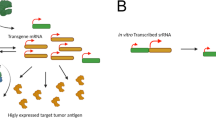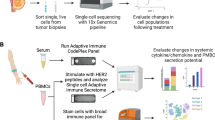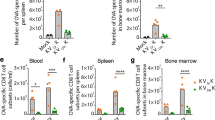Abstract
Cancer vaccines targeting 'self' antigens that are expressed at consistently high levels by tumor cells are potentially useful in immunotherapy, but immunological tolerance may block their function. Here, we describe a novel, naked DNA vaccine encoding an alphavirus replicon (self-replicating mRNA) and the self/tumor antigen tyrosinase-related protein-1. Unlike conventional DNA vaccines, this vaccine can break tolerance and provide immunity to melanoma. The vaccine mediates production of double-stranded RNA, as evidenced by the autophosphorylation of dsRNA-dependent protein kinase R (PKR). Double-stranded RNA is critical to vaccine function because both the immunogenicity and the anti-tumor activity of the vaccine are blocked in mice deficient for the RNase L enzyme, a key component of the 2′,5′-linked oligoadenylate synthetase antiviral pathway involved in double-stranded RNA recognition. This study shows for the first time that alphaviral replicon-encoding DNA vaccines activate innate immune pathways known to drive antiviral immune responses, and points the way to strategies for improving the efficacy of immunization with naked DNA.
This is a preview of subscription content, access via your institution
Access options
Subscribe to this journal
Receive 12 print issues and online access
$209.00 per year
only $17.42 per issue
Buy this article
- Purchase on Springer Link
- Instant access to full article PDF
Prices may be subject to local taxes which are calculated during checkout






Similar content being viewed by others
References
Yewdell, J.W. & Bennink, J.R. Immunodominance in major histocompatibility complex class I-restricted T lymphocyte responses. Annu. Rev. Immunol. 17, 51–88 (1999).
Blum, J.S., Ma, C. & Kovats, S. Antigen-presenting cells and the selection of immunodominant epitopes. Crit. Rev. Immunol. 17, 411–417 (1997).
Donnelly, J.J., Ulmer, J.B., Shiver, J.W. & Liu, M.A. DNA vaccines. Annu. Rev. Immunol. 15, 617–648 (1997).
Leitner, W.W., Hammerl, P. & Thalhamer, J. Nucleic acid for the treatment of cancer: Genetic vaccines and DNA adjuvants. Curr. Pharm. Res. 7, 1641–1667 (2001).
Sasaki, S., Amara, R.R., Oran, A.E., Smith, J.M. & Robinson, H.L. Apoptosis-mediated enhancement of DNA-raised immune responses by mutant caspases. Nature Biotechnol. 19, 543–547 (2001).
Zhou, X. et al. Self-replicating Semliki Forest virus RNA as recombinant vaccine. Vaccine 12, 1510–1514 (1994).
Herweijer, H. et al. A plasmid-based self-amplifying Sindbis virus vector. Hum. Gene Ther. 6, 1161–1167 (1995).
Schlesinger, S. Alphavirus vectors: Development and potential therapeutic applications. Exp. Opin. Biol. Ther. 1, 177–191 (2001).
Schlesinger, R.W. in The Togaviruses (ed. Wengler, G.) 459 (Academic Press, New York, 1980).
Hariharan, M.J. et al. DNA immunization against herpes simplex virus: enhanced efficacy using a Sindbis virus-based vector. J. Virol. 72, 950–958 (1998).
Berglund, P., Smerdou, C., Fleeton, M.N., Tubulekas, I. & Liljestrom, P. Enhancing immune responses using suicidal DNA vaccines. Nature Biotechnol. 16, 562–565 (1998).
Leitner, W.W., Ying, H., Driver, D.A., Dubensky, T.W. & Restifo, N.P. Enhancement of tumor-specific immune response with plasmid DNA replicon vectors. Cancer Res. 60, 51–55 (2000).
Weber, L.W. et al. Tumor immunity and autoimmunity induced by immunization with homologous DNA. J. Clin. Invest. 102, 1258–1264 (1998).
Zhou, A., Hassel, B.A. & Silverman, R.H. Expression cloning of 2-5A-dependent RNAase: a uniquely regulated mediator of interferon action. Cell 72, 753–765 (1993).
Overwijk, W.W. et al. gp100/pmel 17 is a murine tumor rejection antigen: Induction of “self”-reactive, tumoricidal T cells using high-affinity, altered peptide ligand. J. Exp. Med. 188, 277–286 (1998).
Bowne, W.B. et al. Coupling and uncoupling of tumor immunity and autoimmunity. J. Exp. Med. 190, 1717–1722 (1999).
Ying, H. et al. Cancer therapy using a self-replicating RNA vaccine. Nature Med. 5, 823–827 (1999).
Vijayasaradhi, S., Bouchard, B. & Houghton, A.N. The melanoma antigen gp75 is the human homologue of the mouse b (brown) locus gene product. J. Exp. Med. 171, 1375–1380 (1990).
Ito, S. & Jimbow, K. Quantitative analysis of eumelanin and pheomelanin in hair and melanomas. J. Invest. Dermatol. 80, 268–272 (1983).
Overwijk, W.W. et al. Vaccination with a recombinant vaccinia virus encoding a “self” antigen induces autoimmune vitiligo and tumor cell destruction in mice: requirement for CD4(+) T lymphocytes. Proc. Natl. Acad. Sci. USA 96, 2982–2987 (1999).
Player, M.R. & Torrence, P.F. The 2-5A system: modulation of viral and cellular processes through acceleration of RNA degradation. Pharmacol. Ther. 78, 55–113 (1998).
Williams, B.R. PKR; a sentinel kinase for cellular stress. Oncogene 18, 6112–6120 (1999).
Terenzi, F. et al. The antiviral enzymes PKR and RNase L suppress gene expression from viral and non-viral based vectors. Nucleic Acids Res. 27, 4369–4375 (1999).
Zhou, A. et al. Interferon action and apoptosis are defective in mice devoid of 2′,5′-oligoadenylate-dependent RNase L. EMBO J. 16, 6355–6363 (1997).
van Elsas, A. et al. Elucidating the autoimmune and antitumor effector mechanisms of a treatment based on cytotoxic T lymphocyte antigen-4 blockade in combination with a B16 melanoma vaccine: Comparison of prophylaxis and therapy. J. Exp. Med. 194, 481–489 (2001).
Leitner, W.W., Ying, H. & Restifo, N.P. DNA and RNA-based vaccines: principles, progress and prospects. Vaccine 18, 765–777 (1999).
Dubensky, T.W.J. et al. Sindbis virus DNA-based expression vectors: utility for in vitro and in vivo gene transfer. J. Virol. 70, 508–519 (1996).
Johanning, F.W. et al. A Sindbis virus mRNA polynucleotide vector achieves prolonged and high level heterologous gene expression in vivo. Nucleic Acids Res. 23, 1495–1501 (1995).
Sasaki, S. et al. Monophosphoryl lipid A enhances both humoral and cell-mediated immune responses to DNA vaccination against human immunodeficiency virus type 1. Infect. Immun. 65, 3520–3528 (1997).
Perri, S. et al. Replicon vectors derived from Sindbis virus and Semliki forest virus that establish persistent replication in host cells. J. Virol. 74, 9802–9807 (2000).
Albert, M.L., Sauter, B. & Bhardwaj, N. Dendritic cells acquire antigen from apoptotic cells and induce class I-restricted CTLs. Nature 392, 86–89 (1998).
Chen, Z. et al. Efficient antitumor immunity derived from maturation of dendritic cells that had phagocytosed apoptotic/necrotic tumor cells. Int. J. Cancer 93, 539–548 (2001).
Shaif-Muthana, M., McIntyre, C., Sisley, K., Rennie, I. & Murray, A. Dead or alive: immunogenicity of human melanoma cells when presented by dendritic cells. Cancer Res. 60, 6441–6447 (2000).
Restifo, N.P. Vaccines to die for. Nature Biotechnol. 19, 527–528 (2001).
Chattergoon, M.A. et al. Targeted antigen delivery to antigen-presenting cells including dendritic cells by engineered Fas-mediated apoptosis. Nature Biotechnol. 18, 974–979 (2000).
Der, S.D., Yang, Y.L., Weissmann, C. & Williams, B.R. A double-stranded RNA-activated protein kinase-dependent pathway mediating stress-induced apoptosis. Proc. Natl. Acad. Sci. USA 94, 3279–3283 (1997).
Sarid, R., Sato, T., Bohenzky, R.A., Russo, J.J. & Chang, Y. Kaposi's sarcoma-associated herpesvirus encodes a functional bcl-2 homologue. Nature Med. 3, 293–298 (1997).
Revilla, Y. et al. Inhibition of apoptosis by the African swine fever virus Bcl-2 homologue: Role of the BH1 domain. Virology 228, 400–404 (1997).
Clynes, R., Takechi, Y., Moroi, Y., Houghton, A. & Ravetch, J.V. Fc receptors are required in passive and active immunity to melanoma. Proc. Natl. Acad. Sci. USA 95, 652–656 (1998).
Wagner, H. Interactions between bacterial CpG-DNA and TLR9 bridge innate and adaptive immunity. Curr. Opin. Microbiol. 5, 62–69 (2002).
Alexopoulou, L., Holt, A.C., Medzhitov, R. & Flavell, R.A. Recognition of double-stranded RNA and activation of NF-κB by Toll-like receptor 3. Nature 413, 732–738 (2001).
Surman, D.R. et al. Generation of polyclonal rabbit antisera to mouse melanoma associated antigens using gene gun immunization. J. Immunol. Methods 214, 51–62 (1998).
Leitner, W.W. et al. Immune responses induced by intramuscular or gene gun injection of protective DNA vaccines that express circumsporozoite protein from Plasmodium berghei malaria parasites. J. Immunol. 157, 6119 (1997).
Touloukian, C.E. et al. Expression of a “self-”antigen by human tumor cells enhances tumor antigen-specific CD4(+) T-cell function. Cancer Res. 62, 5144–5147 (2002).
Xu, Z. & Williams, B.R. The B56α regulatory subunit of protein phosphatase 2A is a target for regulation by double-stranded RNA-dependent protein kinase PKR. Mol. Cell. Biol. 20, 5285–5299 (2000).
Kumar, A., Haque, J., Lacoste, J., Hiscott, J. & Williams, B.R. Double-stranded RNA-dependent protein kinase activates transcription factor NF-κ B by phosphorylating I κ B. Proc. Natl. Acad. Sci. USA 91, 6288–6292 (1994).
Acknowledgements
We thank L. Finch for FACS sorting, and E.S. Bergmann-Leitner and S. Frank for critical review of the manuscript. Supported in part by grant R01-AI34039 (to B.R.G.W.) and CA44059 (to R.H.S.) from the National Institutes of Health.
Author information
Authors and Affiliations
Corresponding authors
Ethics declarations
Competing interests
The authors declare no competing financial interests.
Rights and permissions
About this article
Cite this article
Leitner, W., Hwang, L., deVeer, M. et al. Alphavirus-based DNA vaccine breaks immunological tolerance by activating innate antiviral pathways. Nat Med 9, 33–39 (2003). https://doi.org/10.1038/nm813
Received:
Accepted:
Published:
Issue Date:
DOI: https://doi.org/10.1038/nm813
This article is cited by
-
Cancer vaccine strategies using self-replicating RNA viral platforms
Cancer Gene Therapy (2023)
-
Nucleases as molecular targets for cancer diagnosis
Biomarker Research (2021)
-
Immunization with a suicidal DNA vaccine expressing the E glycoprotein protects ducklings against duck Tembusu virus
Virology Journal (2018)
-
Combinations of various CpG motifs cloned into plasmid backbone modulate and enhance protective immunity of viral replicon DNA anthrax vaccines
Medical Microbiology and Immunology (2015)
-
Sindbis Viral Vectors Transiently Deliver Tumor-associated Antigens to Lymph Nodes and Elicit Diversified Antitumor CD8+ T-cell Immunity
Molecular Therapy (2014)



